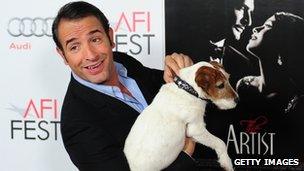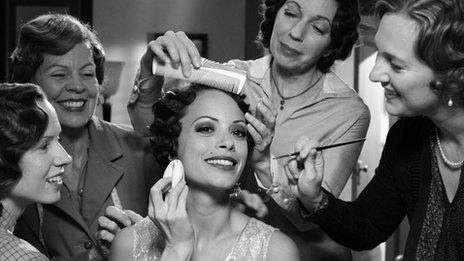The Artist pays homage to Hollywood's silent era
- Published
The Artist is being positioned as an Oscar contender
The Artist is a modern homage to Hollywood's silent era. But how much does it reflect the real silent movies of the period, and could it be the first silent film to win an Oscar in 83 years?
For a silent movie, The Artist is creating a lot of noise.
A glance at the early Oscar predictions for 2012, external shows the The Artist on almost every wish list. Some in Tinseltown, external are already tipping it to win best picture.
What makes The Artist unusual is that it is a 21st Century movie which looks like it was made in 1927. Modern audiences used to 3D, CGI and widescreen must acclimatise to its quaint aspect ratio, monochrome look and lack of dialogue.

Uggie the Jack Russell (seen here with Jean Dujardin) won the "Palm Dog" award at Cannes for his role in The Artist
None of this has prevented Michel Hazanavicius's film from picking up a head of steam since its world premiere at Cannes, where its French star Jean Dujardin won the best actor prize.
Dujardin plays Hollywood leading man George Valentin, who has built his career in silent movies but sees it start to crumble with the advent of "talkies".
Meanwhile, Peppy Miller (Berenice Bejo) is a pretty young extra thrust into the spotlight by a chance encounter with Valentin, who sees her star ascend in the era of sound.
It is a tale of Hollywood in transition that's been told before - notably in 1952's Singin' in the Rain - but The Artist tackles it using the conventions and devices of the silent age.
To what extent does The Artist get it right? According to Bryony Dixon, curator of silent film at the BFI National Archive, director Hazanavicius demonstrates a "profound understanding" of the era.
Ms Dixon, who programmes the annual British Silent Film Festival, external and is the author of 100 Silent Films, sees parallels between Valentin and real-life silent screen stars John Gilbert and Douglas Fairbanks, whose careers declined with the arrival of talkies.
Contrary to popular opinion, she says, in most cases it wasn't just the sound of the actor's voice that led to their demise.
"It happened but it wasn't typical," says Ms Dixon. "There are some careers that do nosedive but they might have done anyway. Studio bosses used the opportunity of the coming of sound to break and renegotiate contracts."
In The Artist, John Goodman plays the studio executive who embraces the switch to talkies. But his big star Valentin isn't so keen to move with the times.
"It was a good opportunity to clear out expensive stars who had got too big for their boots," says Ms Dixon.
"But at any moment in film history you see career trajectories coming and going. What I loved about The Artist is they do it visually with a scene on the staircase where he's going down and she's going up."

Berenice Bejo plays rising star Peppy Miller in The Artist
While the first feature film to use synchronised dialogue was 1927's The Jazz Singer - starring Al Jolson - the actual transition from silent cinema to sound took about five years.
Ms Dixon draws a comparison with the current roll-out of 3D and digital cinema.
"It was very expensive to convert cinemas to sound, in the way that digital projectors are being brought in now. It's a big investment.
"In Hollywood, the transition was carefully planned by the studios. In Europe - where there was less money and cinema was less centrally controlled - it was a bit more haphazard."
Acting styles changed during the four decades of the silent era.
The dramatic gestures of the early 1900s - with their roots in Victorian theatre - became more naturalistic as the camera came in closer to the performers, as exemplified by the career of screen icon Lillian Gish.

Lillian Gish (1893-1993) played waif-type heroines during her silent film career
But the advent of talkies signalled a huge shift in the relationship between actor and director.
"In the silent era, the director could talk to the actor while they were shooting. It was a very personal relationship," points out Ms Dixon.
"As soon as sound comes in you've got the sound guy telling everybody to 'shut up', and everything has to be prepared in advance. And the actor has to learn all those lines."
During the silent era, directors had also been able to play music on set to coax the best performances out of the cast.
Hazanavicius took advantage of this while filming The Artist in Hollywood, playing classics from the likes of Bernard Herrmann and Max Steiner, as well as Ludovic Bource's original score.
"To act in a scene while music is being played is a wonderful way to help you find the mood," he says in the production notes.
Oscar glory?
The Artist, which opens in the US this month and in the UK at the end of the year, isn't the only silent film on the horizon.
Vlad Kozlov's directorial debut, Silent Life, external, is due out in 2012. Shot partially in black and white, it focuses on the life of screen icon Rudolph Valentino, with a cast that includes Isabella Rossellini.
The first, and only, silent film to win an Oscar for best picture was 1927's Wings.
The movie, about fighter pilots in World War I, picked up the prize at the very first Academy Awards ceremony at Hollywood's Roosevelt Hotel in 1929.
Given that Hollywood loves movies about itself, and it has the might of the Weinstein Co behind it, does The Artist have a chance of Oscar glory in 2012?
"Yes, absolutely," Ms Dixon says, without hesitation. "It's clever, without being too clever, and it's so affectionate about its subject matter.
"It's also creating interest in a form of cinema that doesn't get seen a lot. If it kicks open the door to a new audience they'll have 35 more years of cinema to explore, so what's wrong with that?"
The Artist is released in the US on 23 November, and nationwide in the UK on 6 January 2012 (in London on 30 December.)